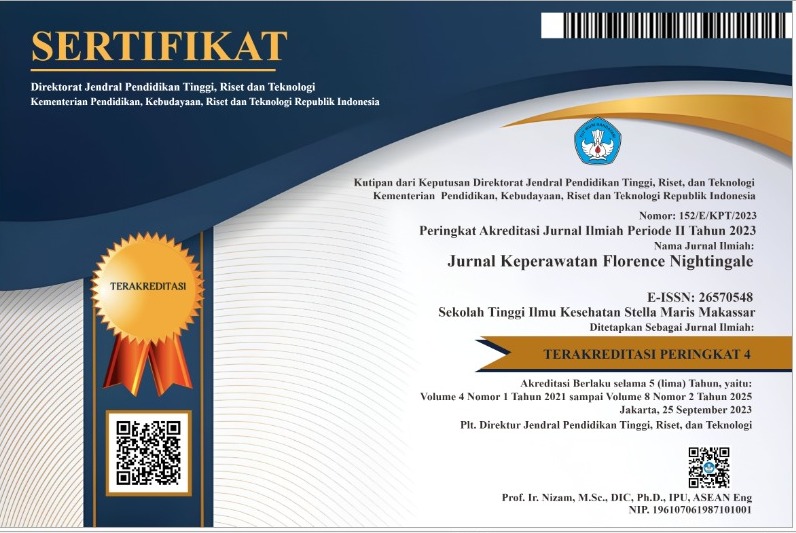The Impact of Screen Time on Sleep in Adolescents: A Scoping Review
Keywords:
screen time, teenagers, sleep latency, sleep quality, sleep disordersAbstract
Screen time is time spent watching television, using a laptop or computer, watching videos, playing games and using devices. In Indonesia, 62.5% of teenagers use social media for more than eight hours per day. Sleep is a basic human need or the main need in Abraham Maslow's hierarchical theory. The aim of this research is to determine the impact of screen time activities on teenagers. The method used was a systematic literature review. Articles were searched using the PubMed, Cochrane and Google Scholar databases. Articles were selected using the PRISMA flow diagram and the quality of the articles was analyzed using JBI (Joint Base Integrated). With eligibility criteria, namely 70% "Yes" score from all questions. Researchers use the boolean operators "AND" and "OR" in searching articles. As a result of the selection, there were 19 articles studied. The article was published in 2017-2023 with research locations in Saudi Arabia, China, India, Indonesia, Japan, Lebanon, Nepal, Pakistan, Taiwan and Turkey. All articles studied used a cross-sectional study design. The conclusion of this study is that screen time activities can have an impact on poor sleep quality, sleep disturbances, longer sleep latency and shorter sleep duration. Additionally, screen time can impact anxiety. stres, depression, overweight and low self-esteem.
Downloads
References
Akbar, R. S., Aulya, A., Psari, A. A., & Sofia, L. (2019). Ketakutan Akan Kehilangan Momen (FoMO) Pada Remaja Kota Samarinda. Psikostudia J. Psikol, 7(2), 38.
Akçay, D., & Akçay, B. D. (2018). The Influence Of Media On The Sleep Quality In Adolescents. The Turkish Journal of Pediatrics, 60(3), 255–263.
Bansal, H., & Kranti, S. K. (2022). Gaming Disorder Among College Students And Correlation Of Gaming With Self-esteem, Perceived Stress, And Sleep Quality. Annals of Indian Psychiatry, 6(3), 244–248.
Cameron, J. D., Maras, D., Sigal, R. J., Kenny, G. P., Borghese, M. M., Chaput, J.-P., Alberga, A. S., & Goldfield, G. S. (2016). The Mediating Role Of Energy Intake On The Relationship Between Screen Time Behaviour And Body Mass Index In Adolescents With Obesity: The HEARTY Study. Appetite, 107, 437–444.
Chandramoorthy, K., Rajendran, P., Newtonraj, A., Rajamanickam, R., & Purty, A. J. (2021). Pattern Of WhatsApp and Facebook Usage And Its Impact On Sleep Quality Among Nursing Students In Pondicherry. International Journal of Community Medicine and Public Health, 8(6), 2799.
Ernstmeyer, & Christman. (2023). Nursing Fundamentals Wisconsin Technical Collage System (WTCS): OPEN Resources for Nursing (OPEN RN).
Farah, F. (2023). Pengaruh Durasi Pemakaian Gawai Terhadap Perkembangan Sosial Emosional Pada Siswa/Siswi SMA Al-Muslim Tambun. Jurnal Kesehatan Dan Kedokteran Tarumanagara, 2(1), 31–38.
Haghjoo, P., Siri, G., Soleimani, E., Farhangi, M. A., & Alesaeidi, S. (2022). Screen Time Increases Overweight And Obesity Risk Among Adolescents: A Systematic Review And Dose-response Meta-analysis. BMC Primary Care, 23(1), 1-9.
Hale, L., & Guan, S. (2015a). Screen Time And Sleep Among School-aged Children And Adolescents: A Systematic Literature Review. In Sleep Medicine Reviews. 21, 50–58.
Hammoudi, S. F., Mreydem, H. W., Abou Ali, B. T., Saleh, N. O., Chung, S., Hallit, S., & Salameh, P. (2021). Smartphone Screen Time Among University Students in Lebanon and its Association With Insomnia, Bedtime Procrastination, and Body Mass Index During The COVID-19 Pandemic: A Cross-sectional Study. Psychiatry Investigation, 18(9), 871.
Hastuti, R. Y., Sari, D. P., & Sari, S. A. (2019). Pengaruh Melafalkan Dzikir terhadap Kualitas Tidur Lansia. Jurnal Keperawatan Jiwa, 7(3), 303.
Huang, T., Liu, Y., Tan, T. C., Wang, D., Zheng, K., & Liu, W. (2023). Mobile Phone Dependency And Sleep Quality in College Students During COVID-19 Outbreak: The Mediating Role of Bedtime Procrastination and Fear of Missing Out. BMC Public Health, 23(1), 1200.
Iqbal, M. D. (2017). Hubungan Aktivitas Fisik Dengan Kualitas Tidur Mahasiswa Perantau di Yogyakarta. Pendidikan Jasmani Kesehatan Dan Rekreasi, 6(11), 1-11.
Irawati, I., Kistan, K., & Basri, M. (2023). The Effect of the Duration of Social Media Use on the Incidence of Student Insomnia. Jurnal Ilmiah Kesehatan Sandi Husada, 12(1), 176–182.
Kumala, A. M., Margawati, A., & Rahadiyanti, A. (2019). Hubungan Antara Durasi Penggunaan Alat Elektronik (gadget), Aktivitas Fisik dan Pola Makan Dengan Status Gizi Pada Remaja Usia 13-15 Tahun. Journal of Nutrition College, 8(2), 73–80.
Muhafilah, I., & Suwarningsih, S. (2023). Durasi Penggunaan Media Sosial dan Tingkat Stres Dengan Kualitas Tidur Pada Remaja. Jurnal Ilmu Kesehatan Masyarakat, 12(05), 346–351.
Muhammad, N., Hussain, M., & Adnan, S. M. (2021). Screen Time And Sleep Quality Among College And University Students of Karachi. Journal of Health & Biological Sciences, 9(1), 1–14.
Mulyana, S., & Afriani, A. (2017). Hubungan Antara Self-esteem Dengan Smartphone Addiction Pada Remaja SMA di Kota Banda Aceh. Jurnal Psikogenesis, 5(2), 102–114.
Natarajan, A., Kanagamuthu, R., Reddy, M. S., & Sindhuja, A. S. (2020). Assessment of Influence of Screen Time on Quality of Sleep Among Dental Students. Ann Int Med Dent Res, 6(5), 1–4.
Neophytou, E., Manwell, L. A., & Eikelboom, R. (2021). Effects of Excessive Screen Time on Neurodevelopment, Learning, Memory, Mental Health, and Neurodegeneration: A Scoping Review. International Journal of Mental Health and Addiction, 19, 724–744.
Ozkan, A. R., Kucukerdonmez, O., & Kaner, G. (2020). Sleep Quality and Associated Factors Among Adolescents. Revista Española de Nutrición Humana y Dietética, 24(3), 256–267.
Sutarsih, T., & Maharani, K. (2022). Statistik Telekomunikasi Indonesia 2022. Jakarta: Bada Pusat Statistik
Tokiya, M., Itani, O., Otsuka, Y., & Kaneita, Y. (2020). Relationship Between Internet Addiction and Sleep Disturbance in High School Students: A Cross-sectional Study. BMC Pediatrics, 20, 1–10.
Wang, P.-Y., Chen, K.-L., Yang, S.-Y., & Lin, P.-H. (2019). Relationship of Sleep Quality, Smartphone Dependence, and Health-related Behaviors in Female Junior College Students. PloS One, 14(4), 1-12.
Wang, X., Li, Y., & Fan, H. (2019). The Associations Between Screen Time-based Sedentary Behavior and Depression: A Systematic Review and Meta-analysis. BMC Public Health, 19(1), 1-9.
Widia Andriani, F., & Indrawati, V. (2021). Gaya Hidup Sedentari, Screen Time, dan Pola Makan Terhadap Status Gizi Remaja SMAN 1 Bojonegoro. Gizi UNESA, 1(1),14-22.
Widyaningrum, R., Studi, P. S., Madani, Stik., Wonosari Km, J., & Bantul Kode, P. (2023). Dampak Screen Time Berlebih Terhadap Perkembangan Bahasa Anak Di Posyandu Balita Tunas Mekar Dusun Monggang The Impact of Excessive Screen Time on Children’s Language Development at Toddlers Posyandu Tunas Mekar Monggang. Jurnal Abdimas Madani, 5(1), 48–54.
Wikanti, C. Z. A., Said, I., & Khairunnisa, A. (2024). Hubungan Kebiasaan Sarapan, Kualitas Tidur, dan Body Image dengan IMT/U Remaja di SMAN 32 Jakarta. Media Gizi Ilmiah Indonesia, 2(1), 1–10.
Windiani, I. G. A. T., Noviyani, N. M. R., Adnyana, I. G. A. N. S., Murti, N. L. S. P., & Soetjiningsih, S. (2021). Prevalence of Sleep Disorders in Adolescents and its Relation With Screen Time During The COVID-19 Pandemic Era. Open Access Macedonian Journal of Medical Sciences, 9(B), 297–300.
Yoga Pratama, A., Maulana, A., Dwi Kurniawan, A., Sadam, S., Maulana, V., Hayati, C., Tinggi Ilmu Ekonomi Mahardhika, S., & Hayati Sekolah Tinggi Ilmu Ekonomi Mahardhika, C. (2023). Dampak Media Sosial Terhadap Remaja. Business, Management, Accounting and Social Sciences (JEBMASS), 1(4), 165-168.
Zhang, Y., Tian, S., Zou, D., Zhang, H., & Pan, C. W. (2022). Screen Time and Health Issues in Chinese School-aged Children and Adolescents: A Systematic Review and Meta-analysis. BMC Public Health, 22(1), 1-12.
Zhu, X., Zheng, T., Ding, L., Zhang, X., Li, Z., & Jiang, H. (2023). Exploring Associations Between Social Media Addiction, Social Media Fatigue, Fear Of Missing Out and Sleep Quality Among University Students: A Cross-section Study. Plos One, 18(10), 1-12.
Published
How to Cite
Issue
Section
Copyright (c) 2024 Haninan Salma Dianah, Nunung Siti Sukaesih, Amanda Puspanditaning Sejati

This work is licensed under a Creative Commons Attribution-ShareAlike 4.0 International License.









